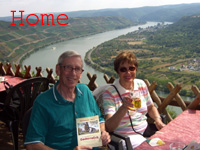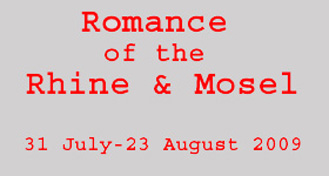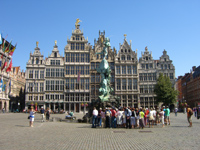Page 1 2 3 4 5 6 7 8 9 10 11 12 13 14 15 16 17
Tuesday, 11 August. The Rhapsody tied up at Traben about 8:00
a.m. Again the morning was cool, overcast and rainy. We left by bus on the
optional tour of Luxembourg at 8:30 and arrived at the Luxembourg-American
Cemetery and Memorial in Hamm just before 10:00. The Cemetery
Administrator led us on a tour. There are 5075 graves, many casualties of the
Battle of the Bulge. Lt. General George S. Patton, who died in a car accident
in Heidelberg after the war, is buried here. The bus then took us to the Sandweiler German
War
Cemetery a mile away. There are nearly 11,000 graves there. The contrast
between the crosses in the two cemeteries was striking, the American ones
gleaming white marble, the German ones dull gray stone.
It was 11:30 before we finally got into Luxembourg City. A local guide led on
a one hour walking tour, including Notre Dame Cathedral (begun 1613),
the Grand Ducal Palace (begun 1572 but greatly expanded
& modified), and the City Hall (1830). We had a delicious lunch in a
local restaurant featuring a large quiche Lorraine, followed by dessert and
some really outstanding coffee. ("Best I've ever tasted." - Jane) Then we were on our own.
Jane and I thought we'd visit the Petrusse Casemates, an elaborate network of underground fortifications (1644). (We'd seen them on our visit here in 1961.) We got as far as the ticket window when we saw a sign cautioning about the hundreds of steep steps to be climbed. Jane said she could never make it, so we gave up that idea. We were near the Place de la Constitution, on the edge of the city center (Centre), so we walked to the edge for a view.
Luxembourg City has some very unusual topography. The Centre district was built on a
high plateau separated from the surrounding area by deep valleys. These
valleys are now spanned by long bridges that connect the various parts of the
city. We were standing between the Adolphe Bridge and the Passerelle Viaduct,
looking into the Petrusse River Valley and across at the Gare district. We walked
past the Casino as far as the Adolph Bridge but realized we wouldn't have
enough time to go further because we had to be on the bus at 3:00.
Once the bus was on the highway that followed the Mosel, we had great views of
the villages below us along the river. The sun even started to come out as we
reached Traben a little before 5:00. While Jane rested, I immediately went out
for a quick look around. Traben is right across the Mosel from Trarbach,
connected by a bridge with a fancy towered gate on the Trarbach side. Like
Bernkastel and Kues, the two villages are now a single entity. The ruins of
the Grevenburg Castle loom over Trarbach. I only had about 20 minutes before I
had to be back on board but, being alone, I managed to see quite a bit, mostly
on the Trarbach side.
Page 1 2 3 4 5 6 7 8 9 10 11 12 13 14 15 16 17
Copyright © 2000-2023 DarrellPeck.com All rights
reserved. | ||||||||||||||||









